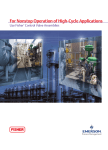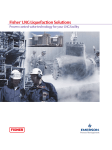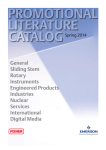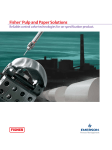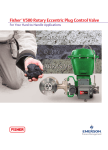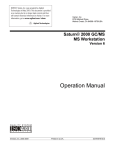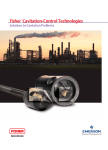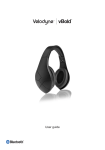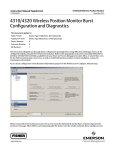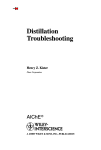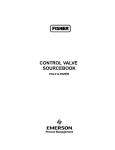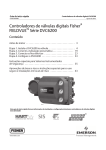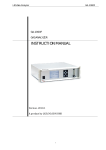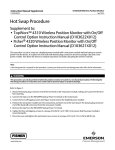Download Emerson Fisher easy-e ED Brochure
Transcript
Fisher Olefins Production Solutions ® 2 | Fisher® Olefin Production Solutions Olefins economics are driven by petrochemicals prices, feedstock costs, product yields, and consumer demand. Traditional feedstocks have included heavier feedstocks including gas oil, naptha, liquifed petroleum gas (LPG), propane, and butane. Today’s availability of non-traditional feedstocks including ethane, propane, and butane from natural gas liquids (NGLs) has led to costadvantaged olefins production with higher ethylene yields. Because of this, unprecedented capital spend is occurring to debottleneck existing plants and to build new facilities. Regardless of the feedstock or process conditions, Fisher® control valves and technologies offer the reliability you need to help you achieve your required product yields. Fisher® Olefin Production Solutions | 3 Brochure ContentsPage Typical Olefins Production Process Diagram................ 4 Hydrocarbon Feed Control Valve................................. 6 Dilution Steam Ratio Control Valve............................. 6 Burner Fuel Control Valve............................................ 8 Boiler Feedwater Regulator and Startup Valve...........10 Boiler Feedwater Pump Recirculation Valve...............10 Steam Vent Valve......................................................12 Quench Tower Level Control Valve............................14 Compressor Antisurge Valve.....................................16 Rich Amine Letdown Valve........................................18 Amine Pump Recirculation Valve...............................20 Gas-to-Flare Valve.....................................................22 Dryer Switching Valve...............................................24 Distillation Feed Control Valve..................................26 Distillation Reflux Control Valve................................26 Lifecycle Services.......................................................28 Emerson Innovation Center.......................................30 Typical Olefins Production Process Olefin production plants use a variety of feedstocks. The type of feedstock used will impact the type of recovery technology used. A frontend de-methanizer configuration is highlighted below because of its ability to allow for a variety of feedstocks. Alternative product recovery configurations include front-end de-ethanizer for plants utilizing light feedstocks and front-end de-propanizer for plants using heavier feedstocks. Most olefin production plants produce between 500 kilotons per annum (ktpa) and 1,500 ktpa per train. Highlighted below are the Fisher control valve solutions offered for critical applications within your facility. 6 | Fisher® Olefin Production Solutions Feed gas into the pyrolysis furnace can be a number of feedstocks, including ethane, propane, butane, gas oil, or naphtha. Regardless of feedstock, the feed rate must be balanced with dilution steam to lower hydrocarbon partial pressure and increase olefin yield. An improper ratio reduces efficiency of the furnace and will impact ethylene conversion. Valves in the furnace section play a critical role in maximizing ethylene production and throughput. Hydrocarbon Feed Control Valve In this particular application, a number of valves in parallel are commonly used to control the flow of the feedstock into the furnace. Reliability is the foremost requirement of inlet feed valves. Unexpected maintenance or surprise failures can stop production. In addition, these valves must be able to provide precise, stable control through a wide range of flow rates from startup and commissioning through full rated output of the plant. These valves must operate with minimal variability to help ensure stable and predictable performance of all process units downstream. Depending on the operating pressure of the pipeline, these valves can also experience a significant pressure drop. If not addressed properly, damaging noise and vibration may occur. Dilution Steam Ratio Control Valve An improper feed-to-steam ratio reduces efficiency of the cracker and can result in the need for additional decoking cycles, therefore reducing furnace uptime. The quantity of steam used varies with feedstock, cracking severity, and design of cracking coils. With the feed-to-steam ratio directly impacting olefin yields, it is important to maintain precise control of that ratio. In addition, steam assists to reduce coking deposits by reacting with coke to form carbon dioxide (CO2), carbon monoxide (CO), and hydrogen (H2). Fisher® Olefin Production Solutions | 7 Fisher ET Control Valve with FIELDVUE DVC6200 Digital Valve Controller 8 | Fisher® Olefin Production Solutions Burner Fuel Control Valve Accurate and precise temperature is needed to maintain optimum furnace performance and prevents undesirable side reactions. Temperature profiles applied along the cracking coil are designed to avoid long residence times at low temperatures. Low temperatures favor reactions involved in the formation of secondary products, thereby reducing olefin yields. The burner fuel control valves regulate the temperature of the furnace by controlling the fuel supplied to the burners. Due to the location by the furnace, burner fuel control valves may be exposed to high ambient temperatures. Emissions from fuel gas can be an environmental concern and must be accounted for in packing design. Fisher® Olefin Production Solutions | 9 Fisher ET Control Valve with FIELDVUE DVC6200 Digital Valve Controller 10 | Fisher® Olefin Production Solutions Boiler Feedwater Regulator and Startup Valve From steam dilution to heat exchange, steam is an essential part of olefin production. The feedwater regulator control valve provides flow to the boiler during normal plant operation when the boiler is under pressure. During this time, the pressure drops are small and cavitation is not a concern. Stable, reliable throttling is most important for efficient boiler operation. The feedwater startup and regulator applications are often combined into one valve. Combined startup and regulation can eliminate cross-over points and ease operation. During startup, the feedwater regulator control valve experiences low flow rates with high differential pressure, which can cause severe cavitation damage. Boiler Feedwater Pump Recirculation Valve The boiler feedwater pump gets its feed from the deaerator at low pressure, and discharges at high pressure above the main steam pressure. During boiler startup or low load conditions, flow may not meet the minimum requirements of the boiler feedpump. The boiler feedwater pump recirculation valve protects the feedpump by ensuring that adequate flow is passing through the pump at all times. A modulating boiler feedwater pump recirculation valve provides an efficient method to prevent cavitation from occurring in the pump. The high pressure drops experienced by the recirculation valve can cause severe cavitation that must be accounted for to ensure long valve trim life. Cavitation abatement trim allows for protection over a range of conditions from boiler startup to full load. Emerson engineers conduct noise and vibration tests on cavitating applications in many different ways. Transparent pipe allows visualization of the cavitation field. No cavitation. Slight cavitation. Full cavitation. Fisher® Olefin Production Solutions | 11 Click on or scan the QR code to discover the broad range of Fisher anti-cavitation technologies for dirty service applications. Fisher HPS Control Valve with FIELDVUE DVC6200 Digital Valve Controller 12 | Fisher® Olefin Production Solutions Steam Vent Valve Boiler startup requires a gradual temperature and pressure increase in the steam distribution system in order to minimize stress on equipment. A steam vent is useful to vent low temperature and pressure steam containing a large amount of moisture. This allows for a gradual warm up of the steam system. In the event of a pressure surge, the vent system prevents overpressure of critical assets. Vent valve applications have potential for noise and vibration due to the high flow and pressure drops experienced. Noise attenuating trim can reduce noise and vibration to acceptable levels. A vent diffuser can also be used for additional noise abatement and allow the valve to operate at a lower pressure drop ratio. Valve shutoff is important as any leakage results in wasted energy. Another consideration to make is valve trim material. Trim must be able to withstand high steam temperatures while maintaining a high level of shutoff. Test programs are conducted on Fisher control valves, valve trim, silencers, diffusers, and spargers as well as tees, elbows, reducers, and expansions to determine their contribution to overall noise. Fisher® Olefin Production Solutions | 13 Scan this code or visit www.FisherSevereService.com to learn about the science of noise attenuation in control valves and our history of solving noise issues in facilities just like yours. Fisher HPD Control Valve with FIELDVUE DVC6200 Digital Valve Controller 14 | Fisher® Olefin Production Solutions Quench Tower Level Control Valve Cracked gas leaving the furnace must be cooled immediately to prevent formation of undesirable products in secondary reactions. Depending upon the feedstock, water or oil is utilized as quenching medium, with oil commonly used for heavier feedstocks. Consistent quench tower operation delivers desirable feedstock conversion. Heavier hydrocarbons removed from the cracked gas leave the bottom of the tower and are separated downstream. Entrained carbon particles, more commonly found in heavier feedstocks, may be present in this stream and can cause control valve trim erosion. Control valves designed for erosive services should be considered to ensure long life and consistent operation. Hardened trim can provide resistance to erosive particles and extend trim service life in these applications. Fisher® Olefin Production Solutions | 15 Fisher V500 Rotary Control Valve with FIELDVUE DVC6200 Digital Valve Controller 16 | Fisher® Olefin Production Solutions Compressor Antisurge Valve The availability and efficiency of a plant’s compressors both have a direct impact on the profitability of the facility. Cracked gas compressor downtime will result in lost production. Unexpected operational issues with any of the plant’s refrigerant loops will lead to reduced yields. Compressors also represent some of the most valuable pieces of equipment within an olefin production facility. Not only will damage to these assets cause lost production, it can also lead to very costly repairs. Antisurge valves provide recycle flow to each stage of the multistage compression trains that are common to olefin production. During startup and commissioning, the valve provides throttling control to recycle a portion of the discharge flow as the compressor is brought up to capacity. During the normal operation of the plant, the antisurge valve will remain closed or slightly open to allow for a small portion of the discharge to be recycled. When closed, it is important that the valve provides tight shutoff to prevent unwanted recycle flow. The primary purpose of antisurge valves is to protect the most critical and expensive pieces of equipment in the plant, the compressors. During a surge event, the valve must respond quickly and accurately in order to recycle the discharge flow back to the suction side of the compressor. Failure of the valve to react quickly can result in severe damage to the impellers of the compressor. Click on or scan this QR code to read about how Fisher optimized antisurge valves have improved compressor performance at facilities just like yours. Fisher® Olefin Production Solutions | 17 Fisher FBT Control Valve with FIELDVUE DVC6200 Digital Valve Controller 18 | Fisher® Olefin Production Solutions Rich Amine Letdown Valve Before further processing, carbon dioxide (CO2) and hydrogen sulfide (H2S) are removed from the cracked gas. The presence of H2S can cause serious corrosion issues, and CO2 can freeze in heat exchange and fractionation equipment. Acid gas removal is accomplished by scrubbing with sodium hydroxide on a once-through basis or in combination with a regenerative solvent (amine). As cracked gas enters the bottom of the acid gas scrubber and flows upward, lean amine solution flowing countercurrent strips the gas of impurities. The rich amine letdown valve serves two purposes. First, it regulates the level of rich amine solution that accumulates in the bottom of the contactor vessel. Second, it facilitates a pressure drop into the downstream flash tank, which liberates a portion of the acid gases entrained in the solution. If not addressed properly through detailed valve sizing and selection, this outgassing of the entrained gases can cause significant vibration and damage to the valve. Fisher® Olefin Production Solutions | 19 Fisher ET Control Valve with FIELDVUE DVC6200 Digital Valve Controller 20 | Fisher® Olefin Production Solutions Amine Pump Recirculation Valve Maintaining the proper flow of lean amine to the acid gas absorber is necessary to ensure sufficient removal of carbon dioxide (CO2) and hydrogen sulfide (H2S) from the cracked gas stream. The lean amine pump ensures the stable flow of amine to the absorber. The amine pump recirculation valve is most commonly used to facilitate startup and commissioning as the acid gas absorber is brought to capacity. This valve controls the pump discharge flow that is routed back to the suction side of the pump. When needed, the recycle flow increases the suction pressure to keep it above the vapor pressure of the amine. As a result, the amine pump recirculation valve must be responsive in order to protect the pump from cavitation damage. Due to the high pressure differential from discharge back to suction, the valve trim must be capable of mitigating the potentially damaging effects of cavitation as it recycles flow. Any unplanned maintenance on these valves due to cavitation damage can bring the amine pumps down and reduce plant throughput. To learn more about how Fisher anti-cavitation technologies can help prevent damage to your valves, view an animation video at www.FisherSevereService.com or scan the QR code. Fisher® Olefin Production Solutions | 20 Fisher ET Control Valve with FIELDVUE DVC6200 Digital Valve Controller 22 | Fisher® Olefin Production Solutions Gas-to-Flare Valve Olefin production facilities have a flare system to safeguard against overpressure of critical assets within the plant and to dispose of any waste gas. Failure of the flare system to successfully relieve pressure from the process can lead to unexpected downtime or damage to costly pressure-retaining equipment. Gas-to-flare valves are installed at numerous locations throughout the gas treatment and recovery section. They are used to control the flow of cracked gas or separated hydrocarbons to the flare stack for disposal. They are primarily used during plant startup, shutdown, or short-duration upset conditions. During these periods, flare valves will experience significant pressure differentials and high flow rates. If not addressed properly, these conditions can lead to excessive noise levels and even damaging vibration. During the normal operation of the plant, gas-to-flare valves will remain closed. Because of this, it is important that these valves maintain tight, long-term shutoff in order to prevent loss of valuable product to the flare stack. Fisher® Olefin Production Solutions | 23 Fisher FBT Control Valve with FIELDVUE DVC6200 Digital Valve Controller 24 | Fisher® Olefin Production Solutions Dryer Switching Valve Cracked gas leaving the compression train is saturated with water that must be removed before fractionation. Without drying, formation of hydrates and ice could cause damage to downstream equipment. Continuous water removal requires multiple adsorption beds. Switching valves are critical for continuous operation between active and regenerating adsorption beds. The valves responsible for switching dryer beds are exposed to high cycles between repairs requiring high reliability. Poorly performing switching valves can create bed disturbance and damage adsorption beads. Response to setpoint and overshoot are contributors to dryer inefficiency. Switching valve design should incorporate high-cycle and setpoint requirements to ensure dryer efficiency. Incorporating Fisher control valve assemblies from Emerson into your high-cycle applications can have significant benefits. Click on or scan the QR code to learn more. Fisher® Olefin Production Solutions | 25 Fisher A81 Control Valve with TopWorx™ DXP Discrete Controller 26 | Fisher® Olefin Production Solutions Distillation Feed Control Valve The efficiency of a distillation column depends on the amount of contact between the vapor rising and the liquid falling through the column. If the amount of vapor and liquid traveling through the column becomes too great, the column can “flood”. When flooding occurs, the efficiency of the distillation column is dramatically reduced, with corresponding drops in product purity. An accurate feed control valve is critical to the success of efficient column operation. A problem feed control valve can cause feed flow oscillations, making the distillation column difficult to control. As a result, the heat added by the reboiler oscillates as well, overheating and underheating the column. The effect of the swing, depending on design, can take anywhere from minutes to hours to reach the ends of the column. A control valve with high rangeability should be considered to maintain control. Distillation Reflux Control Valve Increasing column reflux will improve the purity of the overhead product. This requires more heat for the reboiler to vaporize the lighter components in the reflux. A precise throttling control valve will assist to balance reflux needs and reduce variability. A poorly operating reflux control valve will result in the same flow instabilities as a problem feed valve. Product purities will oscillate and column efficiency will suffer. A control valve providing minimal variability will assist in stable and predictable column performance. ENVIRO-SEAL systems are available for a wide range of pressure and temperature conditions in non-environmental and environmental applications. Click on or scan the QR code to learn why they are a good choice for your facility. Fisher® Olefin Production Solutions | 27 Fisher ET Control Valve with FIELDVUE DVC6200 Digital Valve Controller 28 | Fisher® Olefin Production Solutions You’re Never Alone The way you manage key production assets like control valves directly affects your plant’s efficiency, reliability, and profitability. Emerson Process Management’s Fisher Services provides trusted expertise for control valve maintenance and repair. Whether you’re starting or commissioning a process, scheduling diagnostics and repair, or planning a turnaround with upgrades to optimize and extend your plant’s lifecycle, our network of owned and authorized service centers around the world provide effective maintenance through a network of experienced, highly skilled technicians when and where you need them. To help you maintain your plant’s efficiency and reliability, Fisher Services uses only certified OEM parts and assemblies sourced through local inventories, regional parts distribution centers, and Quick Ship facilities to deliver unmatched response to customer needs. Contact your local sales office to get in touch with the Service Center nearest you. Visit www.Fisher.com or scan the QR code to learn more. Fisher® Olefin Production Solutions | 29 Our extensive network of Service Center locations spans every continent. We’re there for you day or night, when and where you need us, 24/7/365. Visit www.Fisher.com/LifecycleServices or scan the QR code to learn more. 30 | Fisher® Olefin Production Solutions THE CONTROL VALVE YOU CHOOSE MATTERS WHEN YOU HAVE TO ACHIEVE EFFICIENT, PRODUCTIVE, AND RELIABLE PLANT OPERATION. When you buy Fisher control valves, you get the application expertise that comes from more than a century of petrochemical experience. Plus you benefit from millions of dollars of research invested in reliability-centric testing of Fisher control valve technologies. Fisher product specifications are, in many cases, more stringent than the industry accepted standards set by regulatory agencies. Our attention to and evaluation of product quality is necessary to bring you Fisher technologies of the highest reliability and performance. Fisher technology development capabilities extend worldwide with engineers and labs in North America, Europe, and Asia. Using Fisher technology can help you achieve efficient, productive, and reliable plant operation. Want to see for yourself? Visit the Emerson Innovation Center for Fisher Technology in Marshalltown, Iowa, USA. To schedule a visit, please contact your local Emerson sales office. Fisher® Olefin Production Solutions | 31 PRECISE ACTUATION LOW-EMISSIONS PERFORMANCE HIGH-CYCLE TESTING Antisurge valves must be responsive in order to protect critical and costly compressors from damage during transients. Fisher precision actuation technology enables a full stroke up to 50.8 cm (20 inches) in less than one second and better than 1% positioning accuracy. Fisher ENVIRO-SEAL low emissions packing is designed and tested for Fisher control valves to keep fugitive emissions below 100 parts per million volume (ppmv) in your throttling application for tens of thousands of cycles. Many of Emerson’s standard Fisher products are used in extremely high-cycle applications, and must be tested to more than one million cycles. Those same standard products are used in your olefins plant to enhance reliability. WITHSTANDING VIBRATION REDUCING PROCESS VARIABILITY QUIETING NOISE Fisher control valves are designed and tested for robustness in vibration applications. They are subjected to additional testing for millions of cycles at their resonant (worst case) frequency to enhance performance in your facility. Fisher control valve assemblies are subjected to on-line, dynamic performance testing to evaluate their ability to reduce your process variability. These tests replicate how control valves are used in your plant. Supported with a 4,738 m2 (51,000 ft2) facility and a unique 2, 415 m2 (26,000 ft2) sound chamber, Emerson can quantify noise from valves, piping, and vents. This capability provides insight to ensure highly accurate noise prediction and helps you comply with regulatory (IEC) requirements. If you found this brochure valuable, may we also recommend the following literature: Fisher Optimized Antisurge Control Valves ® High reliability to meet world-class production demands “Fisher Optimized Antisurge Control Valves Brochure” Long-Term, Low-Emissions Performance with Fisher ENVIRO-SEAL Packing Systems ® ™ Fisher ENVIRO-SEAL packing systems provide the measure of emissions control security that you require. They are designed and tested for Fisher control valves to keep fugitive emissions below 100 parts per million volume (ppmv) in your throttling application for tens of thousands of cycles. ® Document Number: D352208 www.Fisher.com/Documentation ™ “ENVIRO-SEAL Valve Packing Systems Flyer” Document Number: D352207 www.Fisher.com/Documentation Consider the Differences Between Packing Test Standards There are many fugitive emissions test standards, all with a variety of testing methodologies and passing criteria. Which standards best represent your control valve applications? Control valve test standards require 20,000–100,000 cycles (ANSI/FCI 91-1 and ISO 15848-1) On/Off valve test standards require 1,510 cycles (API 622) ENVIRO-SEAL packing systems have been tested to control valve test standards such as ANSI/FCI 91-1 and ISO 15848-1. In contrast, non-OEM packing typically only adheres to on/off valve test standards such as API 622. Proven Solution for 20+ Years Utilize proven ENVIRO-SEAL packing systems, which have offered reliable fugitive emissions sealing and long cycle life since the Clean Air Act inception of Leak Detection and Repair (LDAR) more than 20 years ago. Non-OEM graphite packing does not measure up to the ENVIRO-SEAL graphite ULF packing system as proven by 2001 Emerson lab testing at 1500 psi and thermal cycling to 600°F without packing adjustment. Packing Design is More Than Controlling Fugitive Emissions The design of packing systems requires an understanding of the entire control valve assembly. ENVIRO-SEAL packing systems are designed and tested for your Fisher control valves. You can meet 100 ppmv leakage and realize low maintenance, long service life, and optimal dynamic performance. ENVIRO-SEAL packing systems have been designed, tested, and validated to extend control valve service life and meet current environmental standards. Non-OEM packing might meet your emissions needs on the first day. In the long run, however, unknown friction and dynamic performance characteristics can impact your loop performance and reduce your bottom line. For Nonstop Operation of High-Cycle Applications Use Fisher Control Valve Assemblies ® “For Nonstop Operation of High-Cycle Operations Brochure” “The Silent Treatment Brochure” The Silent Treatment Fisher Solutions to Noise Problems ® Document Number: D351338 www.Fisher.com/Documentation “FIELDVUE DVC6200 Series Digital Valve Controllers” FIELDVUE DVC6200 Series Digital Valve Controllers ™ Higher Process Reliability and Performance Fisher Cavitation-Control Technologies ® Solutions to Cavitation Problems Document Number: D351908 www.Fisher.com/Documentation main red gradient bottom C0 M96 Y90 K2 C13 M96 Y81 K54 white black C0 M0 Y0 K0 C100 M100 Y100 K100 PMS 1795C WHITE on light backgrounds “Fisher Cavitation-Control Technologies Brochure” Document Number: D351912 www.Fisher.com/Documentation YOUTUBE LOGO SPECS PRINT Document Number: D351989 www.Fisher.com/Documentation on dark backgrounds standard standard no gradients no gradients watermark watermark PMS 1815C BLACK stacked logo (for sharing only) stacked logo (for sharing only) http://www.Facebook.com/FisherValves http://www.YouTube.com/user/FisherControlValve http://www.Twitter.com/FisherValves http://www.LinkedIn.com/groups/Fisher-3941826 To find the Fisher sales contact in your area, scan the QR code. © 2013 Fisher Controls International LLC. All rights reserved. Fisher, Cavitrol, ENVIRO-SEAL, FIELDVUE, NotchFlo, and TopWorx are marks owned by one of the companies in the Emerson Process Management business unit of Emerson Electric Co. Emerson Process Management, Emerson, and the Emerson logo are trademarks and service marks of Emerson Electric Co. All other marks are the property of their respective owners. Emerson Process Management Marshalltown, Iowa 50158 USA Sorocaba, 18087 Brazil Chatham, Kent ME4 4QZ UK Dubai, United Arab Emirates Singapore 128461 Singapore www.Fisher.com D352222X012 / (H:) MZ38 / Dec13 The contents of this publication are presented for informational purposes only, and while every effort has been made to ensure their accuracy, nothing herein is to be construed as a warranty or guarantee, express or implied, regarding the products or services described herein or their use, performance, merchantability or fitness for a particular purpose. Individual results may vary. All sales are governed by our terms and conditions, which are available upon request. We reserve the right to modify or improve the designs or specifications of our products at any time without notice. Responsibility for proper selection, use and maintenance of any product or service remains solely with the purchaser and end user.
































